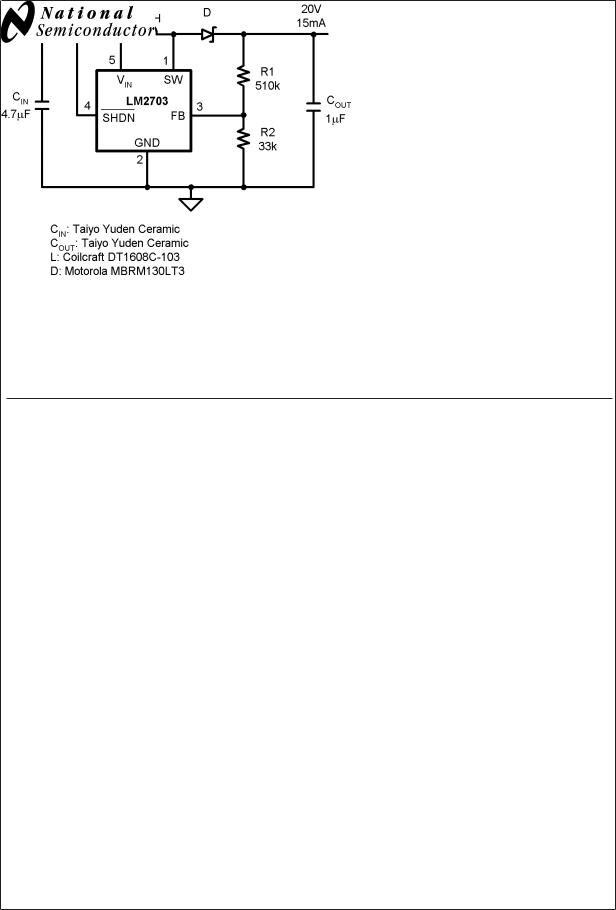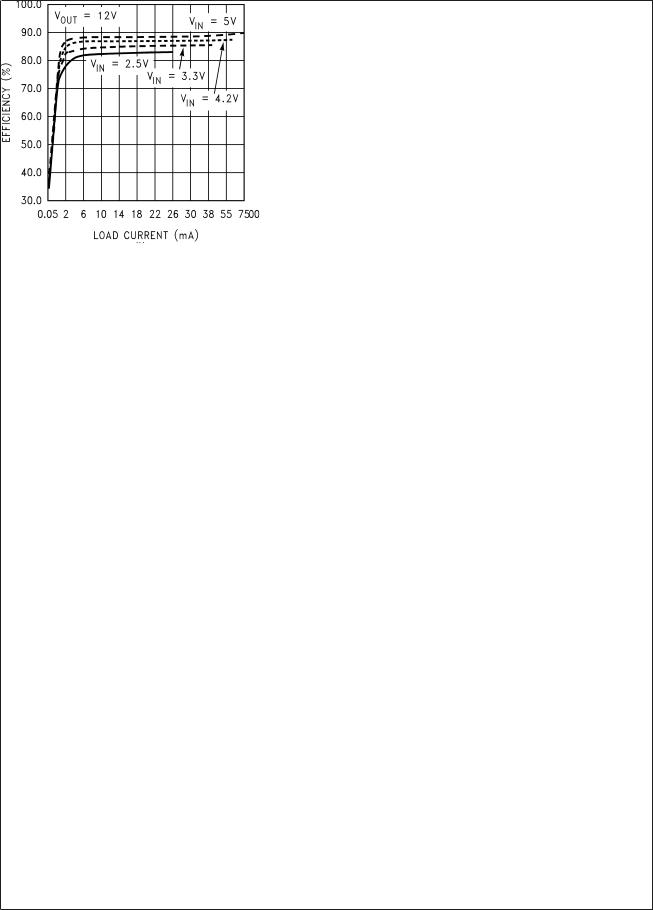NSC LM2703MF-ADJ, LM2703EV, LM2703MFX-ADJ Datasheet

April 2003
LM2703
Micropower Step-up DC/DC Converter with 350mA Peak
Current Limit
General Description
The LM2703 is a micropower step-up DC/DC in a small 5-lead SOT-23 package. A current limited, fixed off-time control scheme conserves operating current resulting in high efficiency over a wide range of load conditions. The 21V switch allows for output voltages as high as 20V. The low 400ns off-time permits the use of tiny, low profile inductors and capacitors to minimize footprint and cost in spaceconscious portable applications. The LM2703 is ideal for LCD panels requiring low current and high efficiency as well as white LED applications for cellular phone back-lighting. The LM2703 can drive up to 4 white LEDs from a single Li-Ion battery.
Features
n350mA, 0.7Ω, internal switch
nUses small surface mount components
nAdjustable output voltage up to 20V
n2.2V to 7V input range
nInput undervoltage lockout
n0.01µA shutdown current
nSmall 5-Lead SOT-23 package
Applications
nLCD Bias Supplies
nWhite LED Back-Lighting
nHandheld Devices
nDigital Cameras
nPortable Applications
Typical Application Circuit
20030601
FIGURE 1. Typical 20V Application
Limit Current Peak 350mA with Converter DC/DC up-Step Micropower LM2703
© 2003 National Semiconductor Corporation |
DS200306 |
www.national.com |

LM2703
Connection Diagram
Top View
20030602
SOT23-5
TJmax = 125˚C, θJA = 220˚C/W (Note 2)
Ordering Information
Order Number |
Package Type |
NSC Package Drawing |
Top Mark |
Supplied As |
|
|
|
|
|
LM2703MF-ADJ |
SOT23-5 |
MA05B |
S48B |
1000 Units, Tape and Reel |
|
|
|
|
|
LM2703MFX-ADJ |
SOT23-5 |
MA05B |
S48B |
3000 Units, Tape and Reel |
|
|
|
|
|
Pin Description/Functions
Pin |
|
Name |
Function |
|
|
|
|
|
|
1 |
|
SW |
Power Switch input. |
|
|
|
|
|
|
2 |
|
GND |
Ground. |
|
|
|
|
|
|
3 |
|
FB |
Output voltage feedback input. |
|
|
|
|
|
|
4 |
|
|
Shutdown control input, active low. |
|
|
SHDN |
|
||
5 |
|
VIN |
Analog and Power input. |
|
SW(Pin 1): Switch Pin. This is the drain of the internal NMOS power switch. Minimize the metal trace area connected to this pin to minimize EMI.
GND(Pin 2): Ground Pin. Tie directly to ground plane.
FB(Pin 3): Feedback Pin. Set the output voltage by selecting values for R1 and R2 using:
Connect the ground of the feedback network to an AGND plane which should be tied directly to the GND pin.
SHDN(Pin 4): Shutdown Pin. The shutdown pin is an active low control. Tie this pin above 1.1V to enable the device. Tie this pin below 0.3V to turn off the device.
VIN(Pin 5): Input Supply Pin. Bypass this pin with a capacitor as close to the device as possible.
www.national.com |
2 |

Absolute Maximum Ratings (Note 1)
If Military/Aerospace specified devices are required, please contact the National Semiconductor Sales Office/ Distributors for availability and specifications.
VIN |
7.5V |
|
SW Voltage |
21V |
|
FB Voltage |
2V |
|
|
7.5V |
|
SHDN |
Voltage |
|
Maximum Junction Temp. TJ |
150ûC |
|
(Note 2) |
|
|
Lead Temperature |
|
|
(Soldering 10 sec.) |
300ûC |
|
Vapor Phase |
|
|
(60 sec.) |
215ûC |
|
Infrared |
|
(15 sec.) |
220ûC |
ESD Ratings (Note 3) |
|
Human Body Model |
2kV |
Machine Model (Note 4) |
200V |
Operating Conditions
Junction Temperature |
|
(Note 5) |
−40ûC to +125ûC |
Supply Voltage |
2.2V to 7V |
SW Voltage Max. |
20.5V |
Electrical Characteristics
Specifications in standard type face are for TJ = 25ûC and those in boldface type apply over the full Operating Temperature Range (TJ = −40ûC to +125ûC). Unless otherwise specified. VIN =2.2V.
|
Symbol |
|
|
Parameter |
|
|
|
Conditions |
Min |
Typ |
Max |
Units |
|
|
|
|
|
|
|
(Note 5) |
(Note 6) |
(Note 5) |
|||||
|
|
|
|
|
|
|
|
|
|
|
|||
|
|
|
|
|
|
|
|
|
|
|
|
|
|
IQ |
|
Device Disabled |
|
FB = 1.3V |
|
40 |
70 |
|
|||||
|
|
|
|
Device Enabled |
|
FB = 1.2V |
|
235 |
300 |
µA |
|||
|
|
|
|
Shutdown |
|
|
|
|
0.01 |
2.5 |
|
||
|
|
|
|
|
SHDN |
= 0V |
|
|
|||||
|
|
|
|
|
|
|
|
|
|
|
|
|
|
VFB |
|
FeedbackTrip Point |
|
|
|
|
1.189 |
1.237 |
1.269 |
V |
|||
ICL |
|
Switch Current Limit |
|
|
|
|
275 |
350 |
400 |
mA |
|||
|
|
|
|
|
|
|
|
|
|
260 |
|
400 |
|
|
|
|
|
|
|
|
|
|
|
|
|
||
|
|
|
|
|
|
|
|
|
|
|
|
|
|
IB |
|
FB Pin Bias Current |
|
FB = 1.23V (Note 7) |
|
30 |
120 |
nA |
|||||
VIN |
|
Input Voltage Range |
|
|
|
|
2.2 |
|
7.0 |
V |
|||
RDSON |
|
Switch RDSON |
|
|
|
|
|
0.7 |
1.6 |
Ω |
|||
TOFF |
|
Switch Off Time |
|
|
|
|
|
400 |
|
ns |
|||
ISD |
|
|
|
|
= VIN, TJ = 25ûC |
|
0 |
80 |
|
||||
|
SHDN |
Pin Current |
|
SHDN |
|
|
|||||||
|
|
|
|
|
|
|
|
|
15 |
|
nA |
||
|
|
|
|
|
|
|
SHDN |
= VIN, TJ = 125ûC |
|
|
|||
|
|
|
|
|
|
|
|
|
0 |
|
|
||
|
|
|
|
|
|
|
SHDN |
= GND |
|
|
|
||
|
|
|
|
|
|
|
|
|
|
|
|
|
|
IL |
|
Switch Leakage Current |
|
VSW = 20V |
|
0.05 |
5 |
µA |
|||||
UVP |
|
Input Undervoltage Lockout |
|
ON/OFF Threshold |
|
1.8 |
|
V |
|||||
|
|
|
|
|
|
|
|
|
|
|
|
|
|
VFB |
|
Feedback Hysteresis |
|
|
|
|
|
8 |
|
mV |
|||
Hysteresis |
|
|
|
|
|
|
|
|
|
|
|
||
|
|
|
|
|
|
|
|
|
|
|
|
|
|
|
|
|
|
|
|
|
|
0.7 |
0.3 |
|
|||
|
SHDN |
|
|
SHDN |
low |
|
|
|
|
|
V |
||
Threshold |
|
|
|
|
|
|
|
|
|
|
|||
|
|
|
|
|
|
|
1.1 |
|
|
||||
|
SHDN High |
|
|
|
|
0.7 |
|
||||||
|
|
|
|
|
|
|
|||||||
|
|
|
|
|
|
|
|
|
|
|
|
|
|
θJA |
|
Thermal Resistance |
|
|
|
|
|
220 |
|
ûC/W |
|||
Note 1: Absolute maximum ratings are limits beyond which damage to the device may occur. Operating Ratings are conditions for which the device is intended to be functional, but device parameter specifications may not be guaranteed. For guaranteed specifications and test conditions, see the Electrical Characteristics.
Note 2: The maximum allowable power dissipation is a function of the maximum junction temperature, TJ(MAX), the junction-to-ambient thermal resistance, θJA, and the ambient temperature, TA. See the Electrical Characteristics table for the thermal resistance. The maximum allowable power dissipation at any ambient temperature is calculated using: PD (MAX) = (TJ(MAX) − TA)/θJA. Exceeding the maximum allowable power dissipation will cause excessive die temperature.
Note 3: The human body model is a 100 pF capacitor discharged through a 1.5 kΩ resistor into each pin. The machine model is a 200 pF capacitor discharged directly into each pin.
Note 4: ESD susceptibility using the machine model is 150V for SW pin.
Note 5: All limits guaranteed at room temperature (standard typeface) and at temperature extremes (bold typeface). All room temperature limits are 100% production tested or guaranteed through statistical analysis. All limits at temperature extremes are guaranteed via correlation using standard Statistical Quality Control (SQC) methods. All limits are used to calculate Average Outgoing Quality Level (AOQL).
Note 6: Typical numbers are at 25ûC and represent the most likely norm.
Note 7: Feedback current flows into the pin.
LM2703
3 |
www.national.com |

LM2703
Typical Performance Characteristics
Enable Current vs VIN |
Disable Current vs VIN |
(Part Switching) |
(Part Not Switching) |
20030605 |
20030606 |
Efficiency vs Load Current |
Efficiency vs Load Current |
20030610 |
20030611 |
www.national.com |
4 |
